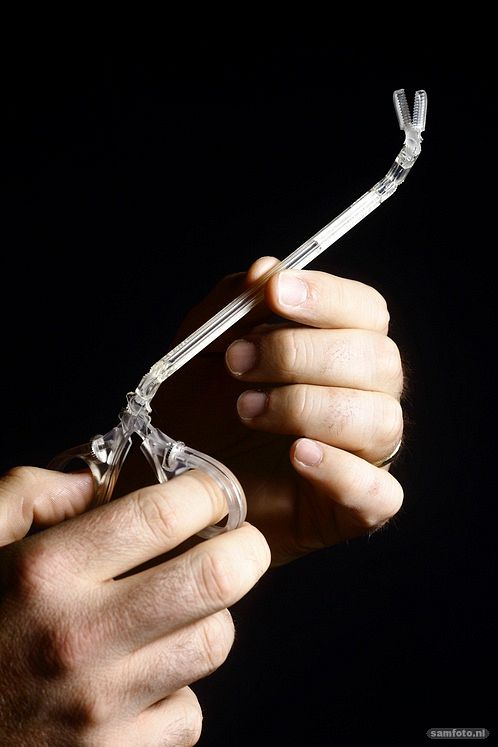Medical Delta celebrated its tenth anniversary last month. Two of the initiators of this collaboration between TU, Leiden University, the LUMC and the Erasmus MC Rotterdam, are biomechanical engineers Professor Jenny Dankelman and Professor Frans van der Helm.
What are their thoughts about the collaboration?
A bed, a heart monitor, infusion poles; the laboratory of the department of biomedical engineering looks just like an operating theatre. In an adjacent room, there are even sterilisation units to clean medical tools after surgery. “The operating theatre is partially for spectacle,” says professor in biomechanical engineering Jenny Dankelman of the Faculty of Mechanical, Maritime and Materials Engineering. “It is meant to enthuse students, but also to test and demonstrate our equipment monitoring system. It is mainly stuff we received from hospitals.”
The research occurring in this laboratory is not just for the spectacle. Students, PhDs and post-docs all work here on new medical instruments. They do so in collaboration with medics from LUMC and Erasmus MC. The three universities have been collaborating in the consortium Medical Delta for ten years now. The consortium is subdivided into three themes: targeted molecular medicine, imaging, and interventions and care. The alliance resulted in many instruments and operation protocols.
“We developed several training systems for surgeons”, said Dankelman. “These are very successful. One of them, the Simendo, a virtual reality trainer for simulating laparoscopic surgery, is extensively used in hospitals. Surgeons need to practise with it and obtain a certain score before they are allowed in the operating theatre.”
At the moment Dankelman and a colleague of hers, Tim Horeman, are working on a tool to perform surgery on the meniscus. It has little punch at the end of a shaft. The tip of the shaft and the punch can move freely in all directions.. “It allows surgeons to operate at the right angle without having to switch over to new instruments all the time,” explained Dankelman. “Changing tools – pulling one out of the body and inserting a new one- is not without risk. So you want to do that the least as possible.”
The biomedical engineering lab resembles Q branch, the lab where James Bond’s gadgets are developed. There are cunning devices in every corner. While one PhD student is testing a controllable needle in an artificial liver, which can be used to scorch tumours, another one is testing a surgical robot arm. Exposed are a training system for simulating epidural needle insertions and a stitching devise that measures the force you exert.
The training systems are already used by training surgeons. Promising as they may seem, the other instruments are not used in practise. “Not yet,” said Dankelman. “I have high hopes that one day they will. It is hard to find businesses that want to invest in the development of new medical instruments.” And as if that wasn’t a big enough hurdle; getting the tools approved and reimbursed by insurance companies also takes years. “All in all, from idea to actual implementation in operating theatre easily take 10 years. Our spin-off companies play a very important role in this process.”
How does the collaboration with medics work in practise? “First of all, when we are asked to work on an instrument or an operation method, we do an observational study”, explained Dankelman. “We assist at ten operations to get a feel of the medical practise. This is very important for us. We as engineers are used to optimise everything and we always have the laws of physics in our mind. Surgeons think differently. They have to decide what to do on vague grounds. They have little time to act. At the end of the day, the patient needs to be stitched up again.”
“When surgeons approach us to ask if we can devise something for them, they often think that we will have the instrument ready in a few weeks’ time. When we meet again, we tell them that we just filled in a four-year research proposal to work on the instrument. There is quite some discrepancy there. But their enthusiasm is very stimulating. What they do is like elite sport. Stitching up veins of 2 millimetres in diameter; it is incredible.”
“I consider the Erasmus MC and the LUMC as my back yard,” said Frans van der Helm of the Faculty of Mechanical, Maritime and Materials Engineering. “There is so much we can do together. For a very long time surgeons were used to working with industry. Companies developed instruments, and doctors were asked to test them. Now that they are working with us, things have changed. Medics have to think about what it is they need, not about what is available for them. That requires a different mind-set.”
“Before Medical Delta was established we already worked together a lot. We used to have many more themes, twelve in total, varying from neuromuscular systems, to minimal invasive surgery, and targeted molecular medicine. Within one theme, you could invite all researchers for a group meeting. If you do that now, with Medical Delta, you have to ask a hundred people. So the collaboration used to be easier to manage. But all in all Medical Delta is a big success.”
Read more about Medical Delta and the new Medical Delta Professors.



Comments are closed.